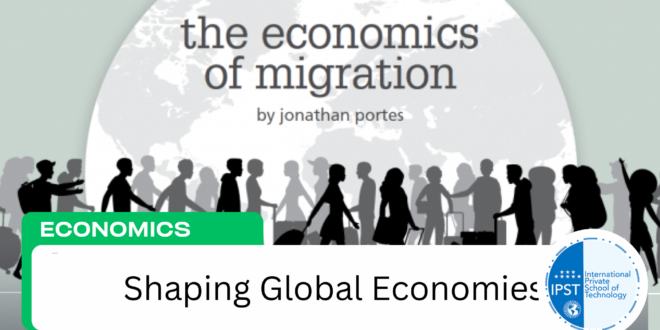In an increasingly globalized world, labor movements through mass migration are having profound economic impacts. Millions of people migrate every year, driven by various factors such as economic opportunities, political instability, and social conditions. This movement of people shapes economies in multiple ways, bringing both challenges and opportunities to both the host and origin countries.
The Positive Economic Impacts of Migration
Mass migration often leads to a labor force expansion in the host country, which can fuel economic growth. Immigrants bring diverse skills and perspectives, filling labor shortages in critical sectors such as healthcare, technology, and agriculture. These workers often contribute to the development of new industries and the growth of existing ones, resulting in increased productivity and higher output.
- Filling Labor Gaps and Boosting Productivity: Many host nations, particularly in developed economies, face labor shortages due to aging populations and low birth rates. Immigrants often step in to fill these gaps, particularly in low-wage and manual labor sectors. This influx of workers helps increase the overall productivity of the economy.
- Supporting Innovation and Entrepreneurship: Immigrants contribute to innovation by bringing fresh ideas and entrepreneurial spirit. Many start new businesses, contributing to job creation and fostering economic dynamism. In fact, studies have shown that immigrants are more likely to start businesses compared to native-born citizens.
- Contributing to Public Finances: While there are concerns about immigrants’ use of public services, studies have shown that immigrants often contribute more in taxes than they consume in public goods. This can provide a fiscal boost to the host country, supporting infrastructure, healthcare, and education systems.
The Challenges of Mass Migration on Host Economies
While mass migration can have economic benefits, it also brings challenges that host countries must address. One of the primary concerns is the potential strain on public resources, such as healthcare, housing, and social services.
- Pressure on Public Services: The sudden influx of migrants can place significant pressure on public services, especially in regions that are not well-equipped to handle large numbers of newcomers. Overcrowded schools, strained healthcare systems, and housing shortages can create tensions between immigrants and native-born citizens.
- Wage Suppression and Job Competition: In certain industries, the influx of low-wage workers can lead to wage suppression, particularly in sectors where labor is abundant. This can create tension between native workers and immigrants, especially if they feel their job opportunities are being threatened.
- Integration Challenges: The integration of large numbers of migrants into the social and cultural fabric of a host country can be difficult. Language barriers, differences in education, and varying cultural norms can make it hard for migrants to fully integrate into society, leading to social divides and even conflict.
The Economic Effects on Countries of Origin
Mass migration also has significant effects on the economies of the countries migrants leave behind. While migration can lead to a “brain drain,” where skilled workers depart in search of better opportunities, it can also offer substantial benefits to these countries.
- Remittances and Economic Support: One of the most significant economic benefits to countries of origin is the flow of remittances. Migrants often send money back home, which can provide a vital source of income for families and communities. These remittances help improve living standards, fund education, and support small businesses, contributing to economic stability.
- Brain Drain vs. Brain Gain: While the departure of skilled workers can lead to a loss of talent in the country of origin, it can also lead to a “brain gain” if migrants return with enhanced skills and experience. Additionally, the international network they build can foster economic ties that benefit the home country in the long term.
- Reduced Pressure on Domestic Job Markets: In some cases, mass migration can help alleviate pressure on domestic job markets in countries of origin, particularly when unemployment rates are high. The migration of workers abroad can reduce competition for local jobs, easing the strain on an already tight labor market.
The Global Economic Picture: A Complex Interplay
The economic effects of mass migration are not limited to the host or origin countries alone. Global economic dynamics are also influenced by labor movements. As migration patterns shift due to political, environmental, and economic factors, the interconnectedness of economies becomes more apparent.
- Global Talent Mobility: Globalization and technological advancements have made it easier for talent to move across borders. High-skilled workers in sectors like IT, healthcare, and finance are increasingly mobile, seeking out the best opportunities worldwide. This creates a global competition for talent that benefits countries with open immigration policies and robust labor markets.
- Labor Markets and Trade: Migration can also affect labor markets in unexpected ways, particularly when it comes to international trade. Countries with large immigrant populations can have access to labor that helps drive their trade competitiveness. Immigrants in key sectors such as manufacturing and logistics can help reduce production costs, boosting exports and strengthening trade ties between nations.
- Regional Economic Cooperation: Mass migration often leads to closer economic ties between neighboring regions. For example, migration flows within the European Union have led to stronger economic integration and collaboration, as countries share labor markets and collaborate on policy solutions to manage migration.
Conclusion
The economic effects of mass migration are complex and multifaceted. While migration brings significant benefits to host countries through a larger, more diverse workforce, it also presents challenges, particularly in terms of public resources and social integration. For countries of origin, the benefits of remittances and the potential for brain gain are significant, though concerns about brain drain persist. As the world continues to grapple with shifting migration patterns, the need for balanced policies that harness the positive aspects of migration while addressing its challenges will be crucial for ensuring sustainable economic growth globally.
 International Private School of Technology المدرسة الدولية الخاصة للتكنولوجيا Private School مدرسة خاصة للتكوين المهني
International Private School of Technology المدرسة الدولية الخاصة للتكنولوجيا Private School مدرسة خاصة للتكوين المهني


